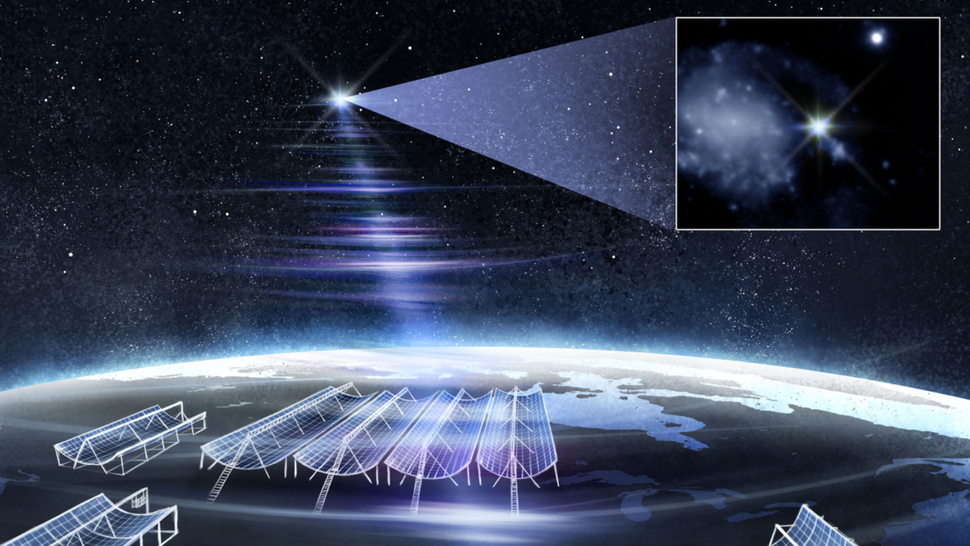Science
Related: About this forumScientists Have Identified the Origin of an Extraordinarily Powerful Outer Space Radio Wave
Aug 23, 2025 6:49 PM
In March 2025 the Earth was hit by a fast radio burst as energetic as the sun, but lasting only milliseconds.
The Earth is constantly receiving space signals that contain vital information about extremely energetic phenomena. Among the most peculiar are brief pulses of extremely high-energy radio waves, known as fast radio bursts (FRB). Astronomers compare them to a powerful lighthouse that shines for milliseconds in the middle of a rough, distant sea. Detecting one of these signals is an achievement in itself, but identifying its origin and understanding the nature of its source remains one of the great challenges of science.
That is why recent research led by Northwestern University in the United States has captured the attention of the astronomical community. The team not only detected one of the brightest FRBs ever recorded, but also traced its origin with unprecedented precision.
The pulse, identified as RBFLOAT, arrived in March 2025, lasted just a few milliseconds, and released as much energy as the sun produces in four days. Thanks to a new method of analysis, the researchers located its origin in an arm of a spiral galaxy located 130 million light-years away, in the direction of the constellation Ursa Major. The research was published in the journal The Astrophysical Journal Letters.
The CHIME radio telescope in Canada, one of the world's leading FRB observatories, and a subnetwork of smaller stations called Outriggers detected the anomalous outburst. CHIME characterized the signal, while the Outriggers triangulated it to a narrow region of space. Optical and X-ray telescopes then provided complementary data. The team achieved a precision of 13 parsecs, equivalent to 42 light-years, within the galaxy NGC 4141.
More:
https://www.wired.com/story/scientists-identified-origin-extraordinarily-powerful-outer-space-radio-wave-frb-chime/
GreenWave
(11,859 posts)Timeflyer
(3,508 posts)ms liberty
(10,754 posts)3Hotdogs
(14,763 posts)a space laser test in Tel Aviv.
llmart
(17,013 posts)They'll be very little research of this sort, at least in our country, if the GOP has it's way, which currently seems to be the plan.
WinstonSmith4740
(3,393 posts)Trump will be shutting down the research lab in 3,2...
oswaldactedalone
(3,590 posts)that the earth is only 6000 years old. The rest is just blasphemy. ![]()
Judi Lynn
(163,984 posts)By Robert Lea
published 3 days ago
"This result marks a turning point: instead of just detecting these mysterious flashes, we can now see exactly where they're coming from."

(Main) An illustration of CHIME/FRB and its Outriggers localizing FRB 20250316A (RBFLOAT) (Inset) RBFLOAT's host galaxy NGC 4141 as seen by MMT Observatory.
An illustration of a quadruple star system with two "failed star" brown dwarfs and two stars (Image credit: Daniëlle Futselaar/MMT Observatory)
Astronomers have discovered what may be the brightest flash of radio waves ever seen and have tracked this fast radio burst (FRB) back to its source. This feat could revolutionize theories surrounding these mysterious and rapid blasts of radiation that, in mere milliseconds, can emit as much energy as the sun does in its entire lifetime.
First spotted in 2007, FRBs have been difficult for astronomers to explain. This is because they last such a brief amount of time and only a small sample of them repeat, making follow-up investigations difficult. Though many explanations have been posited for FRBs, the leading culprits are extreme dead stars or "neutron stars" with magnetic fields so powerful they warrant a categorization of their own and are thus dubbed "magnetars."
The new FRB has been officially designated FRB 20250316A and has been given the nickname "RBFLOAT," which stands for "Radio Brightest FLash Of All Time." This unusually bright FRB was first spotted in March 2025 by the Canadian Hydrogen Intensity Mapping Experiment (CHIME), which has been dubbed an "FRB discovery machine" thanks to its immense impact in spotting new FRBs
This is the first time the CHIME/FRB radio telescope has been used on its own to track an FRB back to its source. In this case, that source is a region just 45 light-years across – smaller than the average star cluster – in the spiral arm at the edge of NGC 4141, a galaxy about 130 million light-years away. To put that feat into context, the team behind the research compares it to spotting a quarter from a distance of 62 miles away.
More:
https://www.space.com/astronomy/brightest-ever-fast-radio-burst-challenges-assumptions-about-mysterious-blasts-of-energy-this-marks-the-beginning-of-a-new-era